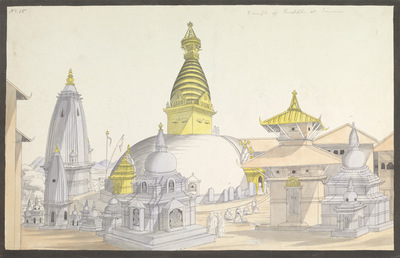Javascript must be enabled to continue!
The stupa at Svayambhunath
View through Europeana Collections
Pencil, wash and watercolour drawing of the stupa
at Svayambhunath in Nepal, part of the Lawrence collection created
by an anonymous artist, c. 1843-1846. The image, set within a black
frame, is inscribed on the front: 'No. 15. Temple at Buddha at Si
mmua.'Nepalese Buddhism is mainly Vajrayana and the stupa of
Swayambhunath is Nepal's most revered Buddhist temple, and one of
the most sacred Buddhist sites in the world. The stupa was founded
in the 5th century AD, yet many believe it is much older. A long
stairway leads up to the eastern side of the stupa and at its head
is a huge copper gilt vajra (thunderbolt), placed on top of a stone
mandala (cosmic plan). The vajra was originally an attribute of
Indra, the Vedic supreme ruler of the Gods. In Vajrayana or Tantric
Buddhism, the thunderbolt has assumed a powerful symbolism, of
indestructibility and purity as strong as a diamond, and of the
flash of intuition or potent awakening of knowledge. It is a
frequent motif in Nepalese art.
Title: The stupa at Svayambhunath
Description:
Pencil, wash and watercolour drawing of the stupa
at Svayambhunath in Nepal, part of the Lawrence collection created
by an anonymous artist, c.
1843-1846.
The image, set within a black
frame, is inscribed on the front: 'No.
15.
Temple at Buddha at Si
mmua.
'Nepalese Buddhism is mainly Vajrayana and the stupa of
Swayambhunath is Nepal's most revered Buddhist temple, and one of
the most sacred Buddhist sites in the world.
The stupa was founded
in the 5th century AD, yet many believe it is much older.
A long
stairway leads up to the eastern side of the stupa and at its head
is a huge copper gilt vajra (thunderbolt), placed on top of a stone
mandala (cosmic plan).
The vajra was originally an attribute of
Indra, the Vedic supreme ruler of the Gods.
In Vajrayana or Tantric
Buddhism, the thunderbolt has assumed a powerful symbolism, of
indestructibility and purity as strong as a diamond, and of the
flash of intuition or potent awakening of knowledge.
It is a
frequent motif in Nepalese art.
Related Results
A caitya at Svayambhunath
A caitya at Svayambhunath
Watercolour drawing of a shrine at Swayambhunath,
part of the Lawrence collection created by an anonymous artist
working in the Nepalese school, c. 1843-1846. The image is set
with...
Judva's Thunderbolt, Shimboonath [Swayambhunath]
Judva's Thunderbolt, Shimboonath [Swayambhunath]
Photograph of the thunderbolt at Swayambhunath in
Nepal. from an album of 30 prints credited to Herzog and Higgins,
taken in ca. 1901 and part of the Curzon Collection. Both Buddhi...
Mandalay. Maha Lawka Maya Zain Pagoda [Kuthodaw
Pagoda]
Mandalay. Maha Lawka Maya Zain Pagoda [Kuthodaw
Pagoda]
Photograph of the Kuthodaw Pagoda at Mandalay in
Burma (Myanmar), taken by Philip Adolphe Klier in the 1890s.
Mandalay, in Upper Burma, was the last capital of the Burmese
kings, f...
Drum panel depicting a stupa with the Buddha Descent from Trayastrimsa Heaven
Drum panel depicting a stupa with the Buddha Descent from Trayastrimsa Heaven
Limestone, Ikshvaku, India (Andhra Pradesh Nagarjunakonda)...
Reliquary in the Shape of a Stupa
Reliquary in the Shape of a Stupa
Rock crystal, early Anuradhapura period, Sri Lanka central or western regions...
Reliquary in the Shape of a Stupa
Reliquary in the Shape of a Stupa
Rock crystal, early Anuradhapura period, Sri Lanka central or western regions...
Reliquary in the Shape of a Stupa
Reliquary in the Shape of a Stupa
Rock crystal, early Anuradhapura period, Sri Lanka central or western regions...











 Your session has timed out for security reasons.
Your session has timed out for security reasons.